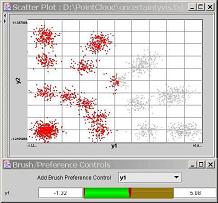Trade Space Exploration Research
The broad goals of our work are to develop the science of trade space exploration, to develop the tools needed to conduct exploration, and to test our methods and tools and real world problems. Three aspects inform our view of the process of making a best selection from a trade space.
- It is a shopping process. The decision maker discovers what it is they want while they are looking for it.
- It is a negotiated process. Decisions of real complexity involve multiple decision makers, each with their own motives and levels of expertise.
- It is an iterative process. The trade space is first explored, and then the knowledge gained is exploited by focusing future searches to regions of decreasing breadth but of increasing depth and detail.
Motivation
While there has been a very extensive and long-lived emphasis on design optimization in the design community little research has been conducted in the area of trade space exploration. And yet, there is a body of research that suggests that the assumptions as to how decision makers form a preference and arrive at a best design do not match the formal structure of the traditional design optimization approach. This matches our own experiences and observatios in working with industry and government. There is a growing interest in industry for tools and method to support trade space exploration in early stages of an acquisition process, where the cost and performance of systems are determined.
Approach
We are focusing our research on existing and new methods for trade space exploration, and on the tools needed to support the methods. Because the methods involve shopping, negotiation, and iteration, the tools need to support exploration, collaboration, and varying levels of detail.
Our work ranges from basic research into the principles of trade space exploration to active support for ongoing projects that are conducting analysis of alternatives. We have applied the tools and methods developed to date to the design of subsurface and surface Navy craft, land vehicles, aircraft, and spacecraft. Sponsors have been from government and industry.

